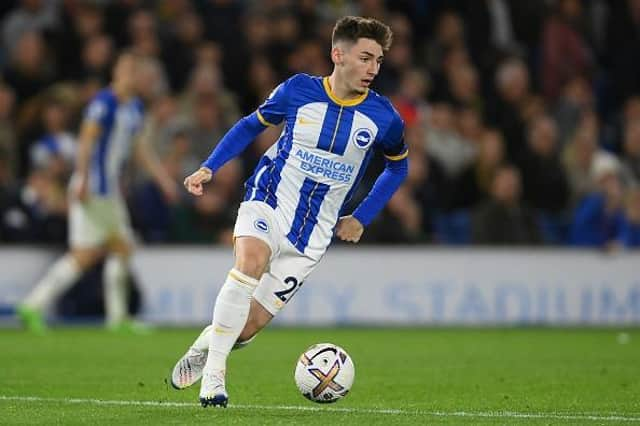Billy Gilmour could be unleashed in new Brighton role as Roberto de Zerbi faces Adam Lallana question


A £9 million fee and a four-year contract have been hailed by many as a bargain for the young Scotsman. Now, joining a team that started their campaign strongly, boasting a midfield duo that has been integral to the team’s successes, he has found only 15 minutes in two substitute appearances for Brighton. After the loss of Graham Potter and the good form that he inspired, Gilmour is tasked with finding his place in an established squad working under an unestablished manager.
Tactically, Gilmour appears to be the perfect fit for Roberto De Zerbi’s Brighton. A player who is at home with the ball at his feet, exhibiting a huge range of distribution, and who can win the ball back efficiently.
Advertisement
Hide AdAdvertisement
Hide AdHaving played most of his career as a deep-lying midfielder, the 21-year-old is comparable to some of De Zerbi’s most successful past players. Manuel Locatelli, now at Juventus, thrived at De Zerbi’s Sassuolo.
In the deep midfield of a 4-2-3-1, Locatelli operated in an attacking role in front of the four-man defence, a role that emulated his idol, Andrea Pirlo. Pirlo will be a name familiar to many as a player of style and clinical technique.
In fact, when describing Gilmour’s play, ex-Chelsea striker David Speedie compared him with Pirlo, "in that every time he plays the ball, he wants it back. It doesn’t matter where he’s played the ball…he’s the closest man ready to receive the ball”. This desperation to control the ball and move it to space is something that directly correlates with De Zerbi’s philosophy.
With the quality of deep midfielders so integral to his system, De Zerbi must have identified Gilmour’s skill set as a desirable one, reminiscent of players who have had success in his past projects.
Advertisement
Hide AdAdvertisement
Hide AdDespite these favourable traits, Gilmour is faced with two sizable obstacles in the form of Moises Caicedo and Alexis Mac Allister. The midfield duo have formed a strong relationship and have often dictated games for Brighton this season. Mac Allister has found new life after having retreated from his No 10 role into that of a deep-lying playmaker, most notably providing a stunning Man of the Match performance against Leicester.
Caicedo, meanwhile, has arguably already outgrown the shadow of Yves Bissouma, a hole in the team which many deemed the 20-year-old unable to fill before the season began. His destructive defensive work and efficient forward threat have cemented him as one of the most exciting young players in the Premier League. The pair’s consistent quality has created real difficulty for Gilmour to break through.
Where can he fit in with these two playing so well? A potential opportunity could arise through the use of a three-man midfield. De Zerbi began his tenure at Sassuolo by playing a 4-3-3, which would leave Gilmour favourite to join the starting midfield. However, after De Zerbi’s first games in England, it appears the Italian will more likely opt for either a 5-2-3 or a 4-2-3-1.
An alternative avenue could be to displace one of the current midfielders. Although a formidable task, Gilmour may believe he can gain an edge by offering his new manager the ability to alter the balance of his midfield. Arguably, the Scot provides a more incisive forward threat than Caicedo, whilst rivalling his off-the-ball impact, and more defensive quality than Mac Allister, whilst possessing similar creativity and distribution.
Advertisement
Hide AdAdvertisement
Hide AdDe Zerbi could have the option to either create a more resolute midfield, by changing Mac Allister for Gilmour, or a more creative one, by changing Caicedo for Gilmour. As one of only two players in the squad with a Champions League winners medal, there are very few doubts about Gilmour’s ability. The question is whether his current skill set alone will be enough to overcome one of these two impressive obstacles and replace them on a regular basis.
Gilmour’s game may have to evolve positionally to earn a starting place. One of Brighton’s strengths has been their positional flexibility and fluidity. Leandro Trossard, for example, has spent time at left wing-back, whilst also impressing in the forward line. Perhaps, under De Zerbi, Gilmour can develop to become a more flexible midfielder, maybe even assuming the No.10 role in a 4-2-3-1.
Tuesday evening’s game saw Adam Lallana start in this role, suggesting it is very much an important feature of De Zerbi’s plans. But after Lallana was replaced in the 64th minute, it is evidently one which is not currently being played to its full effect. Equally, after their loss at Brentford, De Zerbi expressed that "[the last pass] isn’t a goal but it’s more important than scoring…we made a lot of mistakes with the last passes”. With the importance of these passes, and their recent lack of success, can Gilmour prove his quality and impress in more advanced areas of the pitch? In a highly competitive squad, Gilmour may be forced to mature and develop this area of his game in order to be able to establish himself as a regular for Brighton.
In a career that has already been filled with European highs and relegation lows, Gilmour has the potential to become a key Brighton player for years to come. If he can find his role in the side and express his quality, this already promising Seagulls squad will surely start to look more and more like a side fit for Europe.